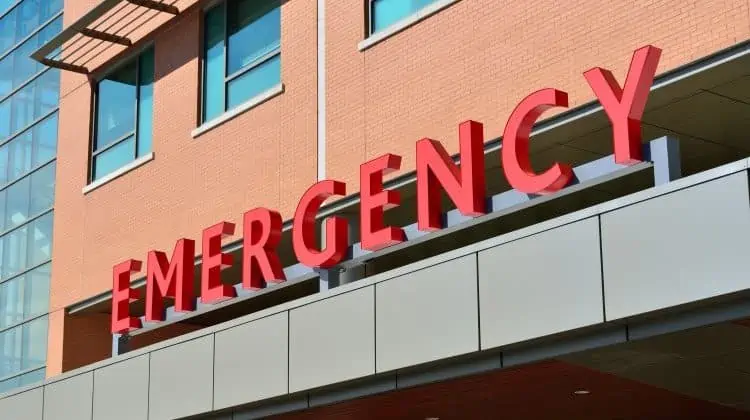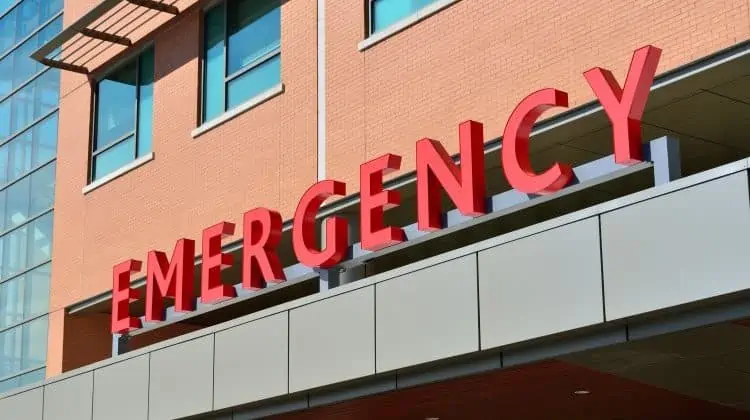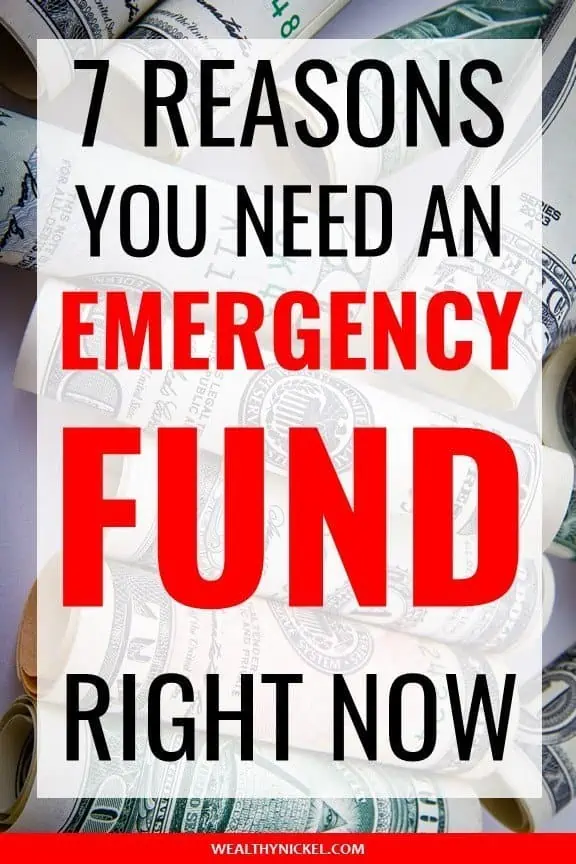Unless you’ve been living under a rock, I’m sure you’ve heard the conventional wisdom that you need an emergency fund.
And of course it makes sense to save for a rainy day. Yet life gets in the way, the normal bills continue to pile up, and emergency savings gets pushed to the back burner. In fact, according to a recent survey, only 39% of Americans could cover a $1,000 emergency expense without dipping into credit cards or some other form of debt.
It makes sense – we tend to prioritize expenses right in front of us instead of the unknown ones of the future. But when the future unknown collides with present reality, it can create a lot of undue stress if you aren’t prepared.
EMERGENCY FUND EXAMPLES
So what are some examples of situations where an emergency fund is a necessity?
Lucky for you, I am one of those people that worries unnecessarily about future uncertainty and hyperventilates when there is less than $10k in the bank account. As such, I have pre-worried about all the possible emergency fund examples so you don’t have to. You’re welcome!
1. Car Expenses
This is the probably the most common “emergency” that is always right around the corner. Whether you get in a wreck and have to pay for expensive repairs (or a $500 or $1,000 insurance deductible), or get a flat tire, almost everyone has to deal with unexpected car expenses a some point.
Having a healthy emergency fund can help you weather the storm and not have to run up your credit card and deal with the stress of paying off the debt for months.
2. Surprise Medical Emergencies
When my daughter was 2, she was running around the house with a wooden spoon in her mouth (don’t ask me why). She ran face-first into the wall and jabbed the spoon into the back of her throat in the soft palate. While it sounds like a ridiculous situation now, in the moment it was extremely scary as she was choking on blood and crying in pain.
We rushed to the emergency room, and it took 3 different doctors before they were satisfied she did not need emergency surgery. Fortunately, they sent her home with some painkillers and a follow-up with a pediatric ENT, and she made a full recovery.
When a medical emergency happens, the last thing you think about is how you’re going to pay for it. Even if you have amazing insurance, most policies these days make you cover several thousands of dollars in expenses out of pocket before you hit the deductible.
We ended up getting a bill for around $1,500 just for the emergency room visit, which was under our deductible so it all had to come out of pocket. Fortunately we save in both an emergency fund and an HSA (Health Savings Account) specifically designed to cover medical expenses like this.
3. Major Home Repairs
Owning a home is great, but when it comes time to replace the roof or call an emergency plumber in Dallas (our hometown), I often wish I was still a renter. Even if the major systems are in good shape, it seems like every few months some unexpected expense comes up that costs us a few hundred (or few thousand) dollars to fix.
Technically, saving for large capital expenses like a new roof or water heater should be a part of your regular budget, not your emergency fund. If your water heater is 23 years old and develops and leak, was that really unexpected? We have a separate fund set up to save money for the large, irregular (but expected) home maintenance items. That’s just part of homeownership.
But then there are the unexpected emergencies that come up. The most recent one for us came during a big storm a few weeks ago. A tree right next to the house split in the high winds and was precariously hanging over the roof. We had to get a tree service out right away to remove the tree before it completely collapsed and took out the roof.
Let me tell you, removing a tree is not cheap. Especially one so close to the house. They have to take extra precautions to take it down in small pieces so as not to damage the roof.
That one tree ended up costing us over $1,000! And since we don’t budget for our regularly scheduled “tree collapsing in storm”, that came straight out of the emergency fund.
RELATED: The True Cost of Homeownership is Higher Than You Think
4. Unexpected Tax Bill
With all the tax code changes in 2018, many people were unsure how much they might owe. Then the stories started coming out of people who owed way more than they thought.
While this can affect anyone, if you are self-employed, get income from alternative sources, or itemize deductions this is more likely to be a potential issue.
Because we have rental properties, our expenses are highly variable. We try to predict how much taxable income we’ll make and withhold appropriately, but sometimes we don’t estimate correctly. Last year we ended up owing more than $10,000 in taxes that we hadn’t planned for!
Not to bore you with the details, but some of our expenses got classified as capital improvements, which you aren’t allowed to fully deduct in that year. And we made a little more income than we thought we would. While making more income than planned is a good problem to have, if we hadn’t set aside some cash in an emergency fund, coming up with a giant tax payment would have been difficult if not impossible.
5. Last Minute Travel
If a friend or family member in another state gets unexpectedly sick, or even worse there is a death in the family, planning for travel and scouring the internet for cheap plane tickets goes out the window.
Booking a flight last minute is notoriously expensive, and you don’t want to have to worry about whether you have enough money to be there for your loved ones in times of need.
Hope for the best, but plan for the worst – this is exactly the kind of situation an emergency fund is designed for.
6. Job Loss
This is the big emergency fund example, and the reason so many personal finance gurus advocate for 3, 6, or even 12 months of expenses saved in an emergency fund.
No one ever plans to be laid off from their job, and depending on you career path and economic conditions it could take awhile to find a new job. (Although there are some simple ways to land a new job quicker than the competition such as by making your resume stand out.) While government unemployment assistance can help, it’s rarely enough to cover all the bills.
In my personal opinion, how much you need to save in your emergency fund in case of job loss really depends on your confidence in being able to find a new job or other way to cover your expenses.
- If you are in a highly volatile industry (e.g. tech startup), or if you have a commission-based income that swings wildly month-to-month, it probably makes sense to have a substantial amount saved.
- If you are in a stable field with a highly in-demand skill set, you can probably get away with saving less.
7. Toddler Destruction
This one is kind of just for fun, but if you’re a parent of young children, the struggle is real.

Among other things, here is a list of things our two toddlers have forced us to fix or replace unexpectedly:
- Our son broke the garage door safety sensor by pulling an LED off the circuit board. Since the missing LED broke the circuit, we could not close our garage door. With $50 and an hour of work, I replaced both sensors so we could have a functioning garage door.
- My daughter got so mad she slammed the door into the wall and there is a nice door-knob sized hold in the drywall. I have yet to fix this…
- I’ve lost count of how many lamps have met their demise when one of our kids accidentally (or purposefully) knocked it off the table.
- My wife’s iPhone passed away before its time when our son chewed on the corner so hard it broke the glass, and his saliva got underneath and destroyed the LDC screen.
Admittedly, these are not huge emergency expenses (although that phone was expensive to replace). But we are fortunate to have a healthy savings account built up to cover the constant tornado of destruction that follows our kids.
RELATED: 51+ Money Jokes to Brighten Your Day
HOW MUCH EMERGENCY FUND SAVINGS DO I NEED?
Despite my anxious disposition toward future uncertainty, the point of these examples is not to scare you into stashing deposits of gold all over your backyard Ron Swanson style.
Everyone’s situation and level of risk tolerance is different. The general consensus advice based on the emergency fund examples is you should have 3-6 months of living expenses saved in an emergency fund.
That is a noble goal, but if you are just getting started with your emergency fund (see statistic above that most people don’t even have $1,000 saved), then I would encourage you to start small.
Start Small – Save $1,000 in an Emergency Fund
Dave Ramsey recommends starting with $1,000 which I think is a great initial goal. This could cover many small emergencies such as a car repair, doctor visit, or home repair.
If saving $1,000 sounds like a mountain to climb in itself, take it step by step. There are lots of ways to save (or make) an extra $1,000 that you probably haven’t thought of, such as:
- Negotiating your insurance policies
- Using cash back apps or survey sites to make a little extra money each month
- Selling stuff you no longer use on Craigslist or FB Marketplace (you’d be surprised how much you can make here)
If you need more inspiration, read this post about 10 Ways I Used to Save $1,000 in 30 Days.
WHERE SHOULD I KEEP MY EMERGENCY FUND?
You need an emergency fund, but where to keep it? Under the mattress? Invested in pork belly futures?
Since you need to have relatively easy access to the money in the short term, investing it in the stock market (or pork belly futures) is too risky. It is not uncommon for stocks to rise or fall by 20% or more, and you don’t want that kind of volatility in your emergency fund savings.
On the flip side, you usually don’t need immediate access to cold hard cash, so keeping it in a jar in the closet will only serve to devalue it over time due to inflation.
I think the absolute best place to keep your emergency fund savings is in a high-yield online savings account. This serves two functions:
- It is just difficult enough to access that you are not as tempted to tap your emergency fund for non-emergencies. Usually it takes a couple days to transfer the money from an online savings account to your personal checking.
- You can earn 2-3% interest on your money until you need to access it. Most traditional banks offer you a ridiculous 0.1% interest rate, but if you put your money in an online-only bank like Ally or CIT Bank you can earn a much higher interest rate.
My Emergency Fund Recommendation: CIT Bank
If you’re looking for a good bank account to hold your emergency fund, or other cash savings, I highly recommend looking into CIT Bank.
By being online only they are able to keep expenses down and offer the best interest rate I can find without sacrificing service.
FIND FINANCIAL STABILITY WITH AN EMERGENCY FUND
While you can’t plan for every scenario, we covered some of the big emergency fund examples:
- Car expenses
- Medical emergencies
- Home repairs
- Unexpected taxes
- Last minute travel
- Job loss
- Toddler destruction
The important thing is to have a plan in place if there is an emergency. In the medical world, professionals are trained on CPR hoping to never have to use it. But if something happens, they are prepared to deal with the situation.
In the same way, your emergency fund is a tool that you hope to never have to use. But if you do, you are prepared and have the peace of mind knowing that you are ready for any financial emergency.
Andrew Herrig is a finance expert and money nerd and the founder of Wealthy Nickel, where he writes about personal finance, side hustles, and entrepreneurship. As an avid real estate investor and owner of multiple businesses, he has a passion for helping others build wealth and shares his own family’s journey on his blog.
Andrew holds a Masters of Science in Economics from the University of Texas at Dallas and a Bachelors of Science in Electrical Engineering from Texas A&M University. He has worked as a financial analyst and accountant in many aspects of the financial world.
Andrew’s expert financial advice has been featured on CNBC, Entrepreneur, Fox News, GOBankingRates, MSN, and more.


